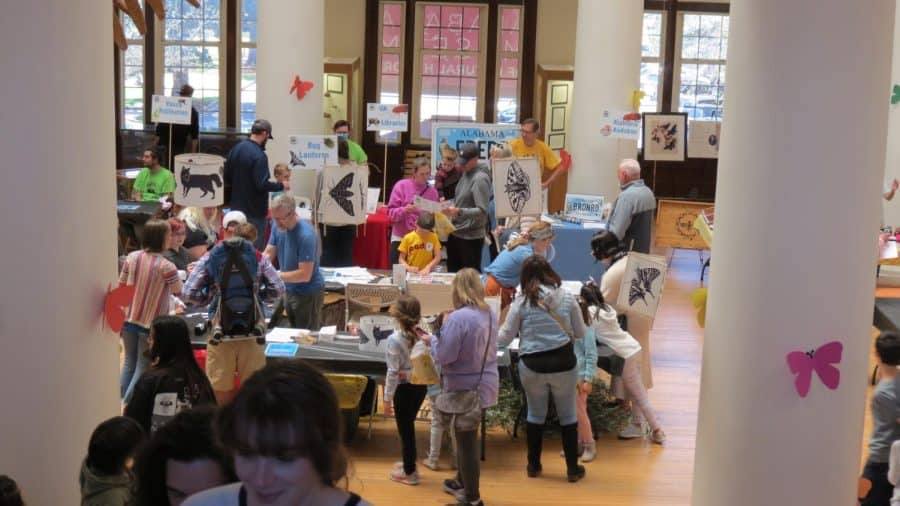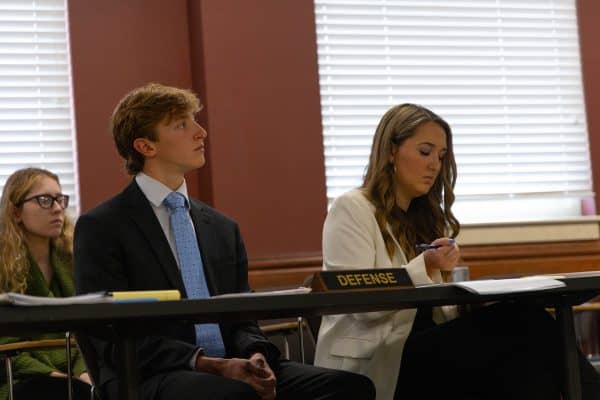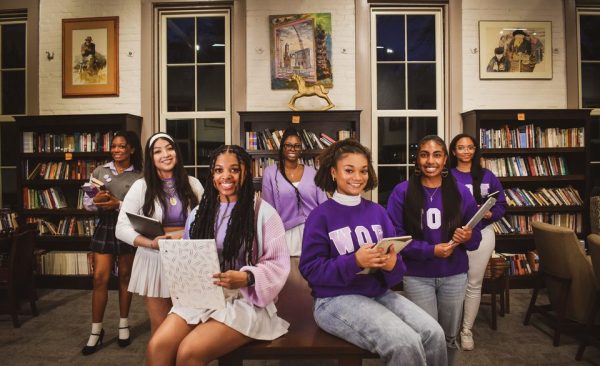Bama Bug Fest highlights the importance of insects
April 20, 2022
The Alabama Museum of Natural History might best be known for its 60-foot ancient whale skeleton, a wooly mammoth skull and the Hodges meteorite. But on April 9, the museum hosted a festival of dinosauric proportions in the celebration of some not-so-dinosaur-sized creatures.
Bama Bug Fest celebrates the insects and bugs that shape our environment and make big impacts despite their size. With thousands of attendees in the span of just four hours, Bama Bug Fest filled all three floors of the Alabama Museum of Natural History.
Volunteers on the first floor handed out maps and flyers while ushering attendees up the grand staircase.
On the second floor, Flow Tuscaloosa had a lantern-making space with insect cutouts and markers for attendees to decorate their own lanterns, which will be lit during a parade at the Tuscaloosa Riverwalk on May 21. Across the way, The University of Alabama Fashion Archive had a display about insects in fashion, particularly focusing on silkworms and cochineals.
The third floor had insect artists, worms, bees and microscopes for attendees to get up close and personal.
Bama Bug Fest had a little something for everyone. The University of Alabama Department of Theatre and Dance projected bug drawings onto the wall and the West Alabama Beekeepers Association showed off a live beehive. A booth on entomophagy taught people how to cook food with bugs.
“Everyone has a fascination with insects,” said Kendra Abbott, the research and outreach coordinator for the Alabama Museum of Natural History and an ecologist. “It may not always be a positive fascination or an appreciation. It might be more that they’re scared or intrigued, but everyone has a fascination with them. And more often than not, people really want to learn about them.”
John Abbott, the chief curator and director of research and collections at the Alabama Museum of Natural History, became interested in insects after his father, who was also a scientist, exposed him to them at a young age.
Kendra and John Abbott, who are married, are no strangers to celebrating bugs. Before they entered their positions at the University, they started an “insect siesta” at their previous jobs at the University of Texas. After moving to Alabama, they wanted to bring their love for bugs and insects to the Capstone and greater Alabama area.
“At its crux, we just love to share our passion for insects, and that’s what it boils down to,” John Abbott said. “We can’t take credit for the idea of an insect festival. There are a number of these all around the country, and some of them are substantial. The North Carolina Museum of Nature and Science brings in something like 40,000 people in one day for their insect festival. Purdue has the Purdue Bug Bowl, where they bring in more people than to a football game. … There’s not one in Alabama, and we just see it as an opportunity and a niche that we could fill.”
Bama Bug Fest started in 2019 with more than 1,500 people celebrating the insects. With the 2020 and 2021 Bug Fests held online due to the COVID-19 pandemic, the Abbotts hoped that their in-person return for 2022 would yield big results, and it did.
Bama Bug Fest has grown in more than just attendance; more UA students than ever before have been helping with the preparations, from manning bug art stations to taking care of the bugs during the semester.
Emily Otter, a sophomore majoring in geology, signed up to work with UA Museums at Get On Board Day and has since worked in the “bug room” in the Alabama Museum of Natural History.
While the bugs typically stay in their room during the year unless a researcher moves them, Bama Bug Fest gives them the unique opportunity to be celebrities for a day.
“I think Bug Fest is important just overall for the University, so we can get people outside of the college involved in the science that we’re doing here and the research that we’re doing here, and just show what students are doing and what is happening on campus, especially for the museum,” Otter said.
Cockroaches, particularly Madagascar hissing cockroaches, ruled the day with two events. On the third floor, volunteers dipped them in paint and let them walk across a piece of paper to create bug art for guests. Here, Otter volunteered to help the cockroaches paint across the page and make their artistic mark.
In a second-floor lecture hall, the cockroaches raced across a miniature raceway lugging tiny tractors while four children chosen out of the crowd tickled them with feathers to get them to move.
Otter hasn’t always been so keen to work with bugs though. Before volunteering at the museum, she said, she was terrified of them, and she isn’t alone.
In Chapman University’s Survey on American Fears, it was found that nearly 25% of respondents are afraid of insects or spiders, which is more than the percentages of people scared of violent crimes and germs.
Bama Bug Fest hopes to change minds just as the museum changed Otter’s. By getting up close and personal with the insects and learning about their diversity, the Abbotts want to change the way we interact with bugs.
Kendra Abbott said 75% of the animals on earth are bugs, with over 5 million species around the world. Despite the magnitude of insects, only around 1 million species have been described and studied.
“The No. 1 thing that I would love people to walk away with is that they don’t need to kill every bug they see. Not every bug is a pest,” Kendra Abbott said. “They’re beneficial, and they do so many things for us. Take a second look at that mantid or cockroach that you see and say, ‘You know what? I’m okay, I’m good.’”
Kendra Abbott said the biggest misconception about bugs is that they’re dirty, when they’re actually constantly cleaning themselves.
“The only reason a roach might be dirty walking across your counters is if you’ve got dirt on your counters,” Kendra Abbott said. “They’re only dirty if you’re dirty.”
To help demonstrate the difference between good bugs and bad bugs, the 2022 Bama Bug Fest was sponsored by Burnum-Hahn Exterminators, a Tuscaloosa-based, family-owned business that’s been serving the West Alabama community since 1946.
Clay Hahn, a vice president and the third generation at Burnum-Hahn, said the company joined Bama Bug Fest to get more involved with the community and to help the Alabama Museum of Natural History educate people about insects.
“We think that everybody should learn about insects and become aware of the good and the bad about insects,” Hahn said. “It’s a time where you can celebrate insects that are beautiful to look at, like caterpillars that turn into butterflies and insects like that, but it’s also important to be aware of insects like roaches, mosquitoes and fire ants that could bring harm to you or any of your loved ones.”
While some bugs can cause harm, such as venomous spiders and virus-carrying mosquitoes, the majority of bugs stay out of the way.
“The vast majority of insects have nothing to do with us, other than [that] the planet that we live on would not survive if there weren’t insects in the way that we know it. Now if all of mankind was to disappear, the planet might, in my opinion, be a better place. If all of the insects would disappear, mankind would disappear,” John Abbott said.
John Abbott said that without bugs, the economy would suffer too because bugs save humans $57 billion per year. From helping leaf litter decompose and eating dead things to pollinating plants around the world — which is done by beetles and butterflies as well as bees — the world would be drastically different without insects, and humans would have a hard time finding food and generally surviving.
“There’s lots of reasons why insects are declining: pesticides, climate change, light pollution,” Kendra Abbott said. “But there is evidence to suggest that there is a huge decline in the abundance of the biomass of insects globally. … Again, that’s a really bad thing.”
Despite bugs suffering from climate change and environmental problems, the Abbotts said there are many ways to help the bug populations.
John Abbott said ditching monoculture and manicured grass lawns and instead allowing the natural flora to prosper is a great way to help insects in your own yard. Many homeowner associations have a minimum amount of space that has to be made of grass in yards, but by planting native plants, people can enable the pollinators to work better and more effectively.
“It’s a rethinking of ‘What is pretty or attractive?’” John Abbott said. “For some people at golf courses, a homogenous grass line that they cut is pretty, but that is not very good for insects. But a meadow of flowers growing and a bush rolling lawn can be very attractive in so many different ways. So it’s just kind of thinking about it differently that way.”
Whether attendees walked away from Bama Bug Fest with new ways to save the endangered insect populations or with a little less fear of bugs than they had before, Bama Bug Fest is happy to give insects their own special day of celebration.
“There is something there for everybody of all ages: the enamored, the curious, the fearful, everybody,” John Abbott said.
This story was published in the Environmental Edition. View the complete issue here.
Questions? Email the culture desk at [email protected].











